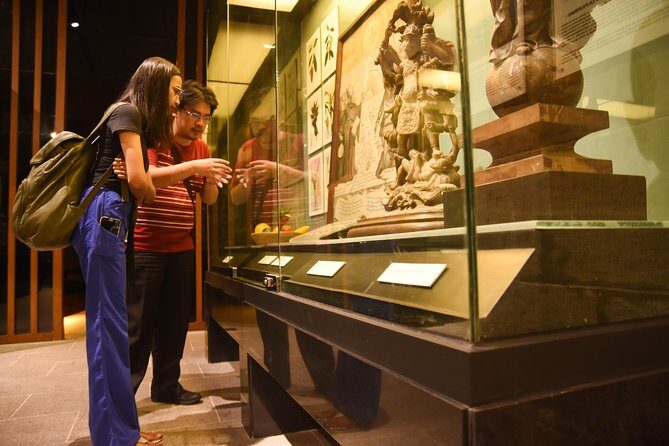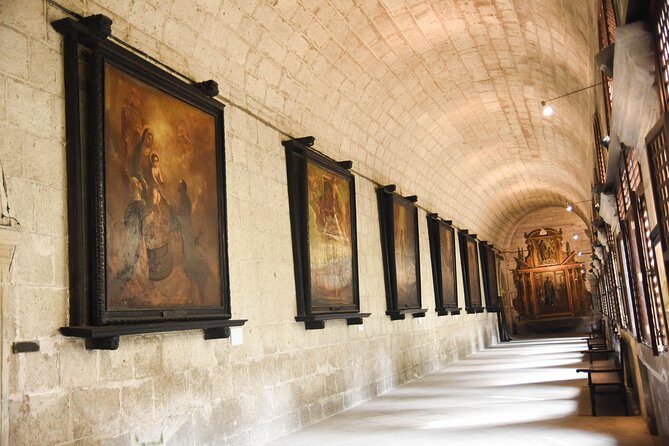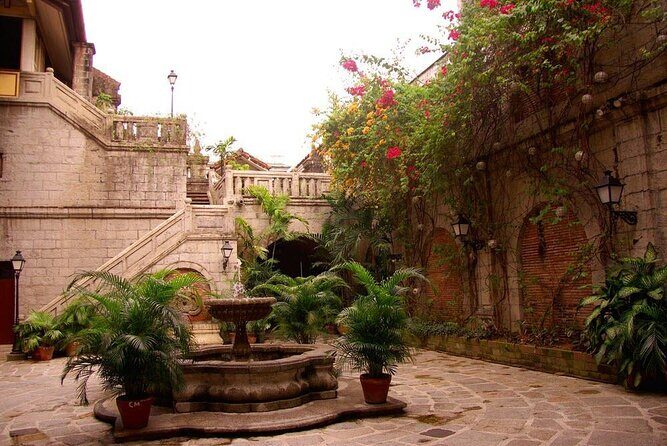Physical Address
304 North Cardinal St.
Dorchester Center, MA 02124
Physical Address
304 North Cardinal St.
Dorchester Center, MA 02124

Discover Manila’s highlights and secrets on this small-group tour exploring San Agustin, Casa Manila, Fort Santiago, and more for a budget-friendly, authentic experience.
If you’re looking to get a meaningful overview of Manila’s history without spending days or breaking the bank, this Introduction to Philippine History tour might just be the perfect fit. It’s a well-rounded, 3-hour exploration that covers key historical sites, with the added bonus of an intimate setting—max 10 travelers—that allows for personalized insights. Guided by knowledgeable locals, you’ll see the iconic landmarks, learn stories behind them, and get a taste of Manila’s complex past, from Spanish colonial influences to WWII scars.
What we love about this tour is how it balances cost-effectiveness with depth. Admission fees are included, so there’s no surprise on the spot, and the small group size makes the experience feel personal and engaging. Plus, the tour’s timing leaves you plenty of room to explore Manila on your own afterward, whether to revisit favorite spots or discover hidden gems.
On the flip side, some reviewers mention that the tour can feel rushed—especially if you’re eager to see everything—and the pace is quick to cover all the highlights. If you’re someone who prefers a more relaxed, unhurried approach, this might be a consideration. Still, for travelers wanting a compact, informative, and lively introduction to Manila’s history, this tour hits the mark.
This tour suits those who are interested in history, culture, and architecture, especially if you’re short on time but want to make the most of your visit. It’s especially valuable for first-timers keen to understand Manila’s story from a local perspective, but it also offers enough depth for history buffs to appreciate.
We love how the tour kicks off at San Agustin Church, which isn’t just any church but the oldest stone church in the Philippines. It’s a true symbol of resilience, having survived the bombings during WWII. The church’s intricate architecture and historical significance immediately set a reverent tone. From the reviews, it’s clear that guides often point out details visitors might overlook, like the lush interiors and the compelling stories behind the artifacts.
The visit lasts around 10 minutes, and entry is free. It’s a perfect opening because it’s centrally located and visually stunning, and it provides a tangible connection to Manila’s past. The fact that it’s a UNESCO World Heritage site adds to its appeal.

Next, the tour moves to the Museo San Agustin, adjacent to the church. This museum isn’t just a collection of old stuff; it’s a portal into the Spanish Galleon Trade that once connected this part of the Philippines to the rest of the world. Guides often highlight artifacts that tell stories of commerce, religion, and colonial influence, making history feel alive.
With about 30 minutes allocated here, you’ll see exhibits that illustrate Manila’s role in global trade and the Catholic Church’s influence. One reviewer shared that their guide’s depth of knowledge made the visit especially meaningful, describing the guide as “friendly and knowledgeable” and noting how he explained the artifacts’ significance clearly.
History buffs will find these Manila heritage tours enlightening

The Casa Manila stop offers a richly detailed recreation of what an upper-class Filipino home looked like around the 19th century. It’s a chance to see authentic furniture, décor, and architectural details that reflect colonial Manila’s lifestyle. The house’s design is both practical and elegant, giving you a real sense of the social hierarchy of that era.
This part of the tour is about 30 minutes long. Reviewers often mention that the guide’s storytelling makes the experience engaging, with many appreciating how it helps visualize life back then. It’s a highlight for those curious about colonial architecture and Filipino adaptations of Spanish customs.
A quick stop at the Memorare Manila Monument offers a sobering moment. This monument memorializes innocent victims of WWII bombing raids, reminding visitors of Manila’s resilience and the cost of global conflicts. The sense of history here is palpable, and guides usually add context about the Philippines’ role during the war.
It’s a brief, 10-minute visit, but the emotional weight is significant. Several reviewers have appreciated this stop, emphasizing its importance in understanding the sacrifices made by Filipinos.
Next, you’ll see the Manila Cathedral, the seat of the Catholic Church in the Philippines. Though brief (about 10 minutes), this stop showcases stunning architecture and religious art. Guides often point out the cathedral’s history, renovations, and role as a spiritual center.
Visitors note that the cathedral’s grandeur and history make it a memorable site, even if only a quick stop. It’s an essential piece of Manila’s cultural fabric, especially for those interested in religious influence.
The tour concludes at Fort Santiago, a historic Spanish military fortress and a symbol of Filipino resistance. This site is packed with stories about heroes like José Rizal, whose execution here sparked the Filipino revolution. The fortress itself offers impressive stone walls, scenic views, and the chance to reflect on Filipino independence.
The 30-minute time slot allows for a relaxed exploration. Reviewers often highlight how guides share fascinating stories about Rizal and other figures, making history feel personal and inspiring. It’s a fitting end point because it captures the spirit of Filipino resilience.
You’ll appreciate that all entrance fees are covered, saving you from surprise costs. Plus, bottled water is provided, ensuring you stay refreshed during the tour. The tour doesn’t include private transportation, so plan accordingly if you’re staying outside Intramuros or prefer to get around independently.
The tour’s price of $55 per person offers solid value considering the inclusion of admission fees and the expert guidance. Compared to other options, it strikes a good balance between affordability and depth.
Reviewers consistently praise the guides’ knowledge and personable manner. Jian and Jerome, in particular, are singled out for their engaging storytelling, humor, and ability to tailor the tour to participants’ interests. For instance, one traveler noted how Jerome made history exciting with his anecdotes and friendly approach.
The small group size (max 10) ensures plenty of interaction and questions. Guests often mention feeling comfortable and well-informed, whether they’re solo travelers or part of a family. The tour’s pacing is generally brisk but informative, with some feedback about it feeling rushed—particularly if the group is eager to linger longer at each site.

Starting at San Agustin Church within Intramuros, the tour is conveniently located near public transportation, making it easy to join. The entire experience lasts around three hours, leaving you free to explore more of Manila afterward. Many reviewers appreciate this flexibility, as they can continue sightseeing, shop, or relax for the remainder of the day.
This tour is perfect for history buffs, first-time visitors, or travelers short on time. If you want a comprehensive yet concise overview of Manila’s colonial past and WWII history**, guided by experts who are passionate and personable, this is a solid choice. It’s especially suited for those who want to feel connected to the sites they visit, thanks to the stories and context provided.
It’s also a great option if you prefer a small-group experience that feels intimate. However, if you’re after a very relaxed pace or want to explore each site in more depth independently, you might find this tour a little quick.
This Introduction to Philippine History tour offers an engaging and immersive way to discover Intramuros’ most iconic sites without feeling overwhelmed. The combination of expert guides, included entrance fees, and a manageable group size makes it an excellent value for those wanting a meaningful glimpse into Manila’s layered past.
Travelers who enjoy stories—whether about Spanish colonists, Filipino heroes, or WWII survivors—will find this tour enriching. It’s also a smart choice for first-timers, history lovers, or anyone eager to get a solid overview before venturing further into Manila or the Philippines.
While some might find the pace a bit brisk, the overall experience remains highly praised for its depth, storytelling, and accessibility. It’s an efficient yet heartfelt way to understand the city’s story and leave with a greater appreciation for its resilience and beauty.
Is this tour suitable for solo travelers?
Absolutely. Many reviews mention solo travelers, and guides are praised for their friendliness and ability to make each participant feel comfortable and engaged.
What’s the meeting point?
The tour starts at San Agustin Church, a central and accessible location in Intramuros.
How long is the tour?
It lasts about 3 hours, covering around six key sites.
Are transportation costs included?
No, private transportation is not included, so plan how you’ll get to and from Intramuros.
What’s included in the price?
All entrance fees and bottled water are covered. You just pay the tour fee itself.
Can I join this tour if I have limited mobility?
The tour involves walking between sites, so consider your mobility needs. It’s best to contact the provider directly for specific accommodations.
Is the tour suitable for children?
Most travelers of all ages enjoy it, especially those interested in history and culture.
How many people are in each group?
A maximum of 10 travelers, ensuring a personalized experience.
What if the weather is bad?
The tour is outdoor and in historic buildings; if canceled due to bad weather, you will be offered a different date or a full refund.